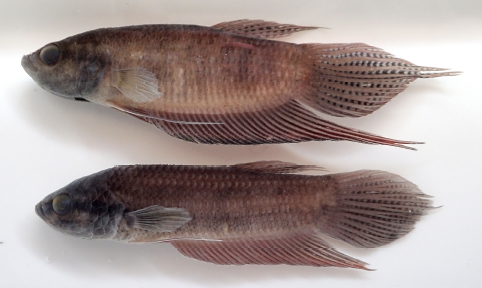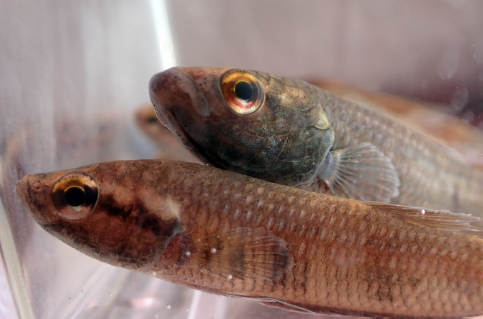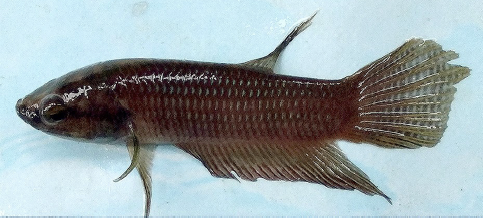There is a new Betta known to science! Authors Kamal, Tan, and Ng (2020) recently described a new species of hill-stream Betta native to Malaysia in the journal Zootaxa.
To some, the thought of a typical fighting fish habitat produces imagery of slow-moving perhaps even stagnant waters. But this is not the case for the newly described Betta nuluhon. Discovered in the Malaysian state of Sabah, B. nuluhon was once thought to be a variety of B. chini, a resident of lowland peat-swamps in western Sabah. The new species, however, was located in the hill streams of the Crocker mountain range (exact coordinates were not provided to prevent illegal collection). The specific epithet is based on the indigenous Kaduzandusun word for “hill”.
Physical description
Betta nuluhon are brown to dark brown with body scales rimmed with bright blue. A dark stripe extends from the upper jaw through the eye to the opercle edge, a dark suborbital stripe and a chin bar are present. The body consists of a yellow dorsal region, black lateral regions, and a reddish ventral region. Male B. nuluhon may exhibit a greenish-blue iridescence on the opercle. The dorsal fin is brown with 4 to 6 traverse bars, the caudal fin has 12 to 16 dark transverse bars, the anal fin is plain with a reddish-brown margin, and the pelvic fin has a whitish second filamentous ray. The fish examined for this study had standard lengths from 39.8 to 62.6 mm.
Ecology
Specimens were collected inside the Crocker Range Forest Reserve in a shallow clear-water stream that had overhanging riparian vegetation and a combination of pebble, sand, and silty substrate. At the time of collection, the water had a temperature of 75°F (24°C), a pH of 6.57, and a dissolved oxygen concentration of 6.25 mg/L. Also present in the collection locale were giant mottle eels (Anguilla marmorata), Bornean spotted barbs (Barbodes sealei), Nematabramis borneensis, Tor tambra, and Gastromyzon introrsus.
Like other members of the Betta akarensis species-group, B. nuluhon are male oral mouthbrooders.

A comparison of a 58.6 mm SL male B. chini (top) to that of a 62.6 mm SL male B. nuluhon. Image from Kamal, Tan, and Ng 2020.
Reference:
Kamal, N.S.S., H.H. Tan, and C.K.C. NG. 2020. Betta nuluhon, a new species of fighting fish from western Sabah, Malaysia (Teleostei: Osphronemidae). Zootaxa 4819 (1): 187–194.
Article Abstract:
Betta nuluhon, a newly described species, is from a hill stream habitat in western Sabah. This species is allied to both B. chini and B. balunga, and differs from the rest of its congeners in the B. akarensis group by having the following combination of characteristics: yellow iris when live; mature males with greenish-blue iridescence on opercle when live; mature fish with distinct transverse bars on caudal fin; slender body (body depth 22.1–25.2 % SL); belly area with faint reticulated pattern (scales posteriorly rimmed with black); absence of tiny black spots on anal fin; lateral scales 29–31 (mode 30); predorsal scales 20–21 (mode 20). Notes on a fresh series of B. chini are also provided.







